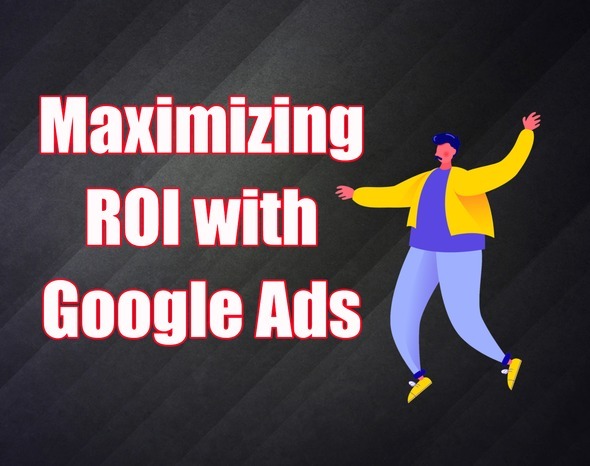
This is a custom HTML / JavaScript Element
In order To See Your Custom HTML/JavaScript Code in Action You Must Click On The Preview Page Button, Your Code is NOT going to be active in the edit mode
ROI (Return On Investment) is an indicator of the success of Google Ads campaigns. It measures the return you get compared to how much you spent.
Conversion tracking to achieve definitive sales attribution is one of the best ways to optimize your budget before it even starts. Here are a few strategies for doing just that.
1. Optimize your Landing Page
Landing pages can be powerful tools for businesses in today's digital world, whether they serve as designated landing pages for call-to-action buttons or the homepage of your website. Landing pages help businesses convert potential leads into customers - but to maximize ROI it's essential that landing pages follow best practices when optimizing them.

Your landing page should reflect the offer that is being promoted, such as using identical language in both headlines and ads for any ads, social posts, blog CTAs or emails promoting it. Doing this helps establish a clear path toward conversion by leading visitors directly towards lead forms with creative directional cues.
Most visitors to your landing page will spend only seconds there before making their decision: whether to stay or go. Their decision will hinge on one simple question: does this provide what I need? If the answer is no, they'll click away in search of something better. In order to prevent bouncing, your landing page must clearly convey its value by outlining exactly what customers can gain by staying.
An effective value proposition is key to building trust with your audience and setting you apart from competitors. One effective way of doing this is highlighting features of your product or service on a landing page - but don't be intimidated into using video as well!
Build trust with your audience by including positive customer reviews on your landing page. These will show potential customers what others think about your product or service and can act as a powerful selling point when people hesitate about making their purchase decision.
2. Optimize your Ad Copy
Though writing ad copy can be challenging, there are a few best practices you should always adhere to when crafting your ads. Ad copy is key when connecting with target audiences and convincing them to engage with your brand; remember that your ads may be competing against hundreds of others for searchers' attention, so stand out with unique messaging to capture it!

Finding the appropriate messaging in your ad copy can drive clicks, leads, conversions and ROI. Understanding your target audience's wants, needs, and desires is critical in crafting effective ad copy that resonates with potential customers.
Ad copy is also an opportunity to demonstrate any unique selling points your business possesses, from customer service excellence and exclusive partnerships to industry expertise and specific knowledge. All these aspects should be highlighted within your ad copy in order to gain an edge against your competition.
Consideration should also be given to the language you use when creating your ad copy. Avoid formal or overly formal language as this may come across as too stuffy and distant for customers to connect with your ad copy, instead use welcoming and friendly to ensure you capture their attention and capture their interest.
As part of your ad group construction, it's also crucial that you take into account the search intent behind each keyword. For instance, if your business deals in furniture, it would likely not make sense for ads related to "wooden chairs" to appear when someone searches "furniture." Doing so could confuse viewers and potentially result in their abandoning the search process altogether.
Notably, your Google Ads account also allows you to create lists of negative keywords - terms you do not wish for your ad to show up for. This tool can help reduce unnecessary clicks and ultimately lower ad costs.
3. Optimize your Ad Images
Your paid advertising budget is finite, so every penny counts. That's why it is critical that you regularly audit and optimize the ad images you use - ensure that they match up with keywords you're targeting, are of high-quality images representing what products or services you provide and boost click-through rates (CTR) while increasing ROI. Image extensions can also help increase CTR.

When trying to reduce your Google Ads campaign budget, it's essential that you focus on metrics you can control and improve. Of these metrics, return on ad spend (ROAS) is of vital importance; this measures how much money your campaigns are earning per dollar spent.
To optimize your return, conversion tracking can help maximize your Return On Investment (ROI). By measuring sales or leads generated through paid advertisements, this allows you to see which campaigns are performing well and are worth investing in. AdStage allows for monitoring and analyzing performance across various platforms so you can track ROI with ease.
Set clear goals and track your progress toward them to stay on target for your paid advertising efforts. While this can be challenging when working within tight timelines or limited budget constraints, creating and sticking to an actionable plan will give you confidence that paid ads are driving positive results for your business.
Google Ads campaigns should never become mired in vanity metrics; by keeping these five pillars of paid advertising at the forefront of your mind, you can rest assured that they're providing maximum return.
4. Optimize your Ad Layout
If you want to boost the return on investment of your Google Ads campaign, there are numerous tactics available to you. From tweaking ad copy and images, using negative keywords, and tapping into Google Analytics data - there are various optimization techniques you can employ in order to boost performance and achieve increased clicks that could result in an improved conversion rate.

One of the key aspects of improving your Google Ads campaign is making sure that the ad text and landing page match. If your ads lead to pages that don't relate directly to what's advertised, they won't be effective and could quickly drive away visitors. You can also optimize placement by targeting locations, times of day or devices with specific ads - this way your ads show up when people are most likely to click them!
Another effective strategy for optimizing Google Ads is identifying user search intent. You can achieve this by creating ad groups that specifically target specific search terms and using negative keywords to stop your ads from showing up for irrelevant searches, for instance if you sell books you shouldn't target "dressers" or "wooden chairs". Focusing your ads toward their intended audiences while eliminating click-bait clicks will improve ROI while increasing return on investment (ROI).
Paid advertising can be an effective way to drive more visitors and convert more customers, but it can become costly without proper management and optimization of campaigns. By following the tips outlined here, you can increase ROI using Google Ads while growing your business.
5. Optimize your Ad Text
Google Ads have become one of the key components for digital marketers looking to generate traffic and sales growth. Therefore, its importance in driving increased web traffic cannot be overstated.

One of the key considerations when running Google Ads is your ad position. Your SERP placement determines how many people see and click your ad; generally speaking, ads at the top receive more clicks than those at lower positions; therefore optimizing your text ad to reach its intended target audience is essential for its success.
To optimize your ad's position, Google's Ad Preview and Diagnosis tool provides a useful analysis of its performance. It will show if and when your ads can appear on SERPs as well as their average position over time.
Ad Extensions can also help your ad performance, providing extra visibility and information about your product or service. Available both Search and Display campaigns, Ad Extensions can be added to increase its exposure and add features such as phone number, address, sitelinks, videos, apps etc.
As Google Ads becomes ever more competitive, advertisers should keep up with best practices and trends to maximize ROI and ensure that paid marketing efforts deliver maximum return. Good luck with your Ads efforts!
 Add Row
Add Row  Add
Add 



